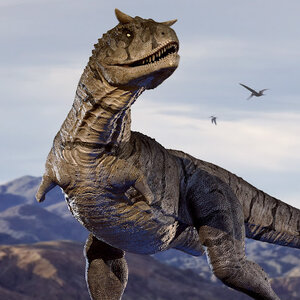
Carnotaurus
CBUB Wins: 0
CBUB Losses: 0
CBUB Ties: 0
Win Percentage: 0%
Added by: Mercenaryblade
Read more about Carnotaurus at: Wikipedia
Official Site: Public Domain
Carnotaurus is a genus of theropod dinosaur that lived in South America during the Late Cretaceous period, probably sometime between 71 and 69 million years ago. The only species is Carnotaurus sastrei. Known from a single well-preserved skeleton, it is one of the best-understood theropods from the Southern Hemisphere. The skeleton, found in 1984, was uncovered in the Chubut Province of Argentina from rocks of the La Colonia Formation. Carnotaurus is a derived member of the Abelisauridae, a group of large theropods that occupied the large predatorial niche in the southern landmasses of Gondwana during the late Cretaceous. Within the Abelisauridae, the genus is often considered a member of the Brachyrostra, a clade of short-snouted forms restricted to South America.
Carnotaurus was a lightly built, biped predator, measuring in length and weighing at least . As a theropod, Carnotaurus was highly specialized and distinctive. It had thick horns above the eyes, a feature unseen in all other carnivorous dinosaurs, and a very deep skull sitting on a muscular neck. Carnotaurus was further characterized by small, vestigial forelimbs and long, slender hind limbs. The skeleton is preserved with extensive skin impressions, showing a mosaic of small, non-overlapping scales approximately 5 mm in diameter. The mosaic was interrupted by large bumps that lined the sides of the animal, and there are no hints of feathers.
The distinctive horns and the muscular neck may have been used in fighting conspecifics. According to separate studies, rivaling individuals may have combated each other with quick head blows, by slow pushes with the upper sides of their skulls, or by ramming each other head-on, using their horns as shock absorbers. The feeding habits of Carnotaurus remain unclear: some studies suggested the animal was able to hunt down very large prey such as sauropod, while other studies found it preyed mainly on relatively small animals. Its brain cavity suggests an acute sense of smell, while hearing and sight were less well developed. Carnotaurus was probably well adapted for running and was possibly one of the fastest large theropods.
The only skeleton (holotype MACN-CH 894) was unearthed in 1984 by an expedition led by Argentinian paleontologist José Bonaparte. This expedition also recovered the peculiar spiny sauropod Amargasaurus. It was the eighth expedition within the project named "Jurassic and Cretaceous Terrestrial Vertebrates of South America", which started in 1976 and was sponsored by the National Geographic Society. The skeleton is well-preserved and (still connected together), with only the posterior two thirds of the tail, much of the lower leg, and the hind feet being destroyed by weathering. The skeleton belonged to an adult individual, as indicated by the fused sutures in the . It was found lying on its right side, showing a typical death pose with the neck bent back over the torso. Unusually, it is preserved with extensive skin impressions. In view of the significance of these impressions, a second expedition was started to reinvestigate the original excavation site, leading to the recovery of several additional skin patches. The skull was deformed during fossilization, with the snout bones of the left side displaced forwards relative to the right side, the nasal bones pushed upwards, and the pushed backwards onto the . Deformation also exaggerated the upward curvature of the upper jaw. The snout was more strongly affected by deformation than the rear part of the skull, possibly due to the higher rigidity of the latter. In top or bottom view, the upper jaws were less U-shaped than the lower jaws, resulting in an apparent mismatch. This mismatch is the result of deformation acting from the sides, which affected the upper jaws but not the lower jaws, possibly due to the greater flexibility of the joints within the latter.
CBUB Match Record:
No Regular Play Records Available
No Fantasy Draft Records Available
